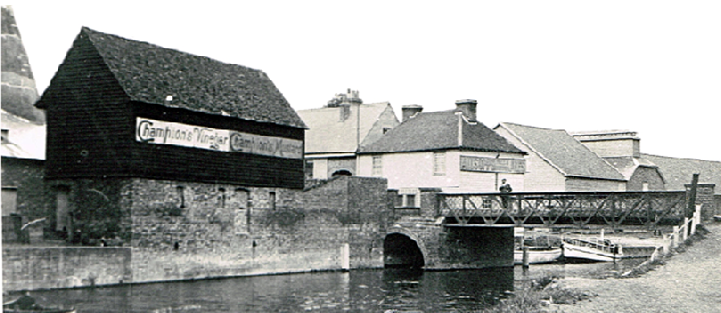Stanstead Abbotts Local History Society
Champions Vinegar
DID STANSTEAD HAVE A VINEGAR DISTILLERY
By
RON DALE
In a comprehensive street by street history of Clerkenwell in London, we encounter
the company history of Booth’s Gin as they started this most successful company in
Cowcross Street, Clerkenwell about 1770. (See British History Online, Survey of London,
vol. 46, South & East Clerkenwell, Temple, 2008, pp182-
It began as a partnership between John Mootham and Philip Booth, but by 1772 they had parted company and the firm was known as Philip Booth & Co. This Cowcross Distillery was to establish the Booth family for 200 years and the Booths empire eventually became the largest gin distillery in the country. In time the business passed into the hands of Philip’s sons, Felix, William and John.

This vinegar malting was advertising Champion Vinegar (Champion & Slee Ltd.) in the late 19th century. Was this originally the “gin distillery” of Booths Gin recorded in 1787? (Picture: Brian Johnson)
Other distilleries were built and by 1830 William had died and John had retired, leaving Felix Booth in sole charge. We have already outlined in detail his philanthropic sponsoring of the Arctic Expedition in an earlier report, which earned Felix a Baronetcy. One interesting gem of information wrapped up in this company’s history however, concerns Stanstead Abbotts. It is recorded here that one of their ventures to increase business was to become distillers of vinegar, but as nothing further was heard of this, it appears to have been a failure. However, the company records state that: ‘By 1787 Philip Booth & Co. had acquired other properties and they also had a distillery at Stanstead Abbotts, Hertfordshire.’
As there is no mention of a gin distillery in Stanstead Abbotts elsewhere at
any time in its history, it can only be assumed that the distillery Booths opened
here was for vinegar, made from the product Stanstead Abbotts is famous for, the
local malt. We know from Edwardian postcard illustrations that a company called Champion
& Slee Ltd, a very successful company, was advertising their product boldly on a
wooden malting on the riverside next to the northern side of the bridge and it is
possible this building had been there for a century or more. Was this the malting
first opened for Philip Booth, but soon abandoned to others when he changed his mind
and decided to concentrate on what he did best? It seems most likely. Champion &
Slee Vinegar had a factory in Old Street, London in 1850 and the vinegar was bottled
there, but the malt came from Stanstead Abbotts. This Champion Vinegar Malting was
shown on a map of the village in 1880 but was demolished by 1921. The old bottles
of Champion Vinegar are attractively shaped and, although of low value, thet are
collected in the U.S.A. and Australia. As such bottles were expensive to produce
the company re-